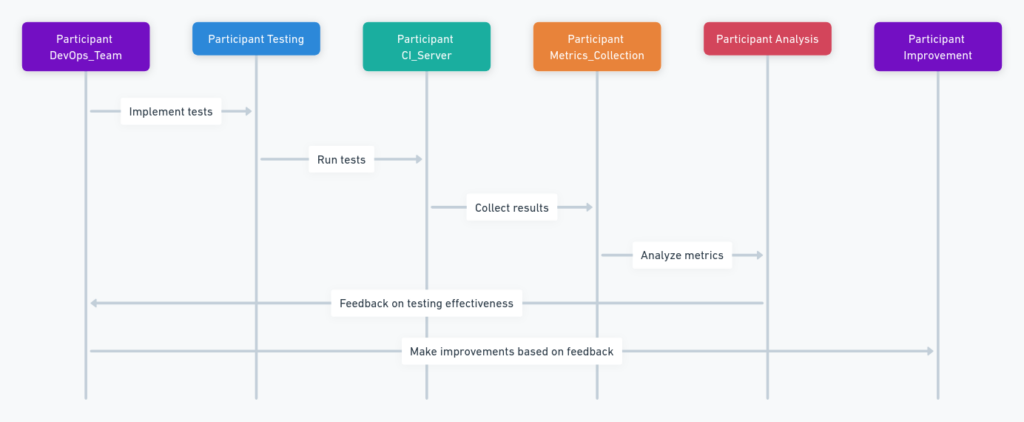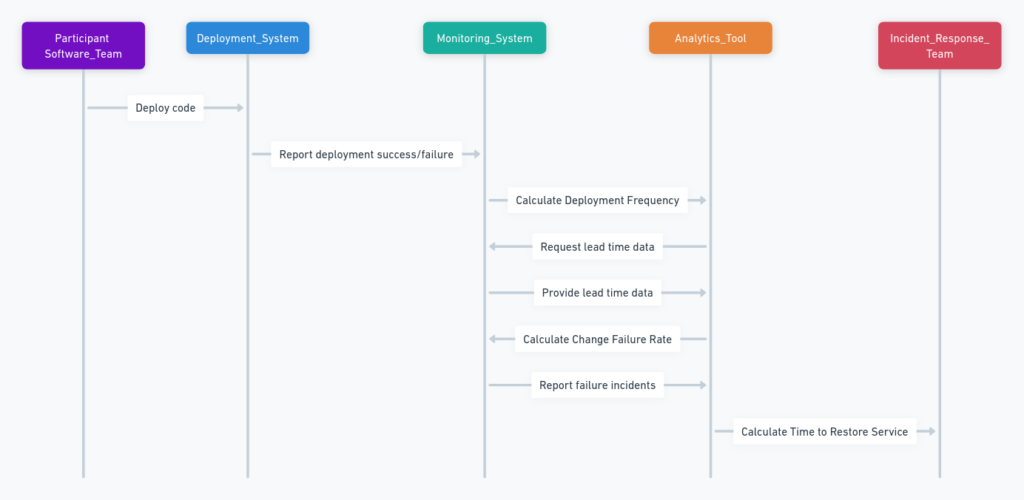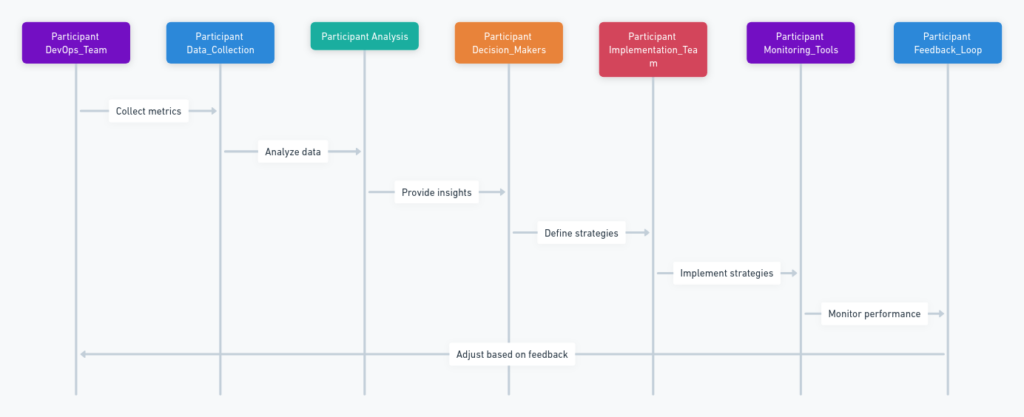Ensuring quality and reliability in software development is of utmost importance, especially as teams strive to accelerate development cycles while still meeting high standards.
DORA (DevOps Research and Assessment) metrics have emerged as a prominent framework to measure software testing processes.
In this guide we explore some key DORA metrics related to test automation and quality assurance processes so organizations can better understand their testing efficiency, improve strategies for testing strategies, and ultimately deliver more reliable products.
Understanding DORA Metrics
What Are DORA Metrics?
DORA Metrics, short for DevOps Research and Assessment metrics, are performance indicators designed to assess the effectiveness of software development and operations (DevOps) practices within an organization.
Originally devised by the DevOps Research and Assessment team, DORA metrics offer organizations insight into how quickly, reliably, and quality software can be delivered - specifically the core metrics being deployment frequency, lead time for changes, mean time to recover timeframe and change failure rate - essential tools when conducting comprehensive CI/CD environments.
Importance of DORA Metrics in Software Testing

DORA metrics serve as crucial measures of software testing teams' efficiency. By monitoring these key performance indicators, organizations can identify bottlenecks in processes and enhance product quality.
These metrics help businesses assess how frequently and reliably new software or features are being provided to users. These reports also shed light on an organization's ability to respond quickly in case of failures and how quickly teams can transition from committing code into production environments.
DORA metrics provide quality assurance processes with an invaluable way to measure team speed without sacrificing standards of quality and reliability that are key for user satisfaction and competitive advantage.
Essential DORA Metrics to Measure Software Testing Success

Deployment Frequency
Deployment frequency measures how frequently an organization successfully releases to production.
Teams practicing Agile or DevOps typically aim to increase deployment frequency as this metric reveals more iterative development processes with less manual intervention required by larger deployments.
Frequent smaller releases reduce risk associated with each release and enable teams to identify and address defects more efficiently; tracking this metric allows teams to gauge progress towards agile delivery practices.
Lead Time for Changes
Lead time for changes is the amount of time between code commit and successful code running in production, measured as days. This metric serves as an important measure of pipeline efficiency--from development, testing, to deployment.
A shorter lead time often indicates more efficient processes and better collaboration among teams; shorter times allow organizations to quickly respond to business and customer needs for feature releases or bug fixes faster.
Optimizing this metric usually involves improving test automation strategies, improving CI/CD pipelines and creating an atmosphere of cooperation among development and operations teams.
Mean Time to Recover (MTTR)
Mean Time to Recover (MTTR) measures the average time it takes for services to recover from failures (e.g., an unplanned outage or defect that impacts users) and restore operations back to their operational state.
MTTR serves as an indicator of team agility; when lower values indicate the team can respond rapidly without significantly impacting end users, an improvement would indicate they've done just that.
Improving this area often involves employing monitoring systems with effective incident management processes as well as having well-prepared teams that can react swiftly on issues without major impact to end users - both improvements that improve reliability as well as customer trust & satisfaction!
Reducing MTTR not only increases system reliability but also maximizes customer trust by minimizing disruptions to service delivery - another important measure taken toward customer trust & satisfaction by minimizing disruptions reducing disruptions to service disruptions reducing customer trust and satisfaction by minimizing disruptions to service delivery!
Strategies for Utilizing DORA Metrics

Establish Measurable Goals
Effective DORA metrics usage starts with setting clear and measurable goals. Before diving into each metric's details, organizations should outline what success looks like within their developmental and operational environments.
Goals must be specific, measurable, attainable, relevant and timely (SMART). By aligning DORA metrics with these goals, teams can establish a more focused benchmarking framework.
If the objective of your team is to reduce lead times for changes, you'll need to define an objective percentage reduction over a particular timeframe.
Setting deployment frequency goals will allow teams to incrementally enhance their delivery processes - not only is this beneficial in quantifying improvements efforts but it helps align these efforts with larger business goals as well.
Implementing Test Automation Technologies.
Automated testing can help to take full advantage of DORA metrics like deployment frequency and change fail percentage, by providing consistent and reproducible checks every time code changes are made; thus facilitating more frequent and reliable releases.
Automated testing can dramatically shorten lead times for changes and increase success rates of deployments. Automation tools can be integrated into a CI/CD pipeline to run tests whenever changes are pushed to a codebase, guaranteeing only thoroughly tested code is deployed to production.
Teams should focus on automating regression tests first before expanding to include other forms of testing such as performance and security analysis for maximum quality standards.
Enhance Quality Assurance Processes
Enhancing quality assurance processes is integral to effectively applying DORA metrics and ultimately increasing software delivery performance.
This requires more than simply automating tests; rather, it demands taking an holistic approach towards quality. Early and frequent quality checks help identify defects at their most cost-effective point in development, when corrective actions can be implemented more cost effectively.
Shifting left requires collaboration among developers, testers, and operations teams in order to ensure quality is shared among all parties involved.
Regular training sessions, pair programming, code reviews and feedback loops can all contribute to building a culture of quality within teams.
Furthermore, using tools that offer insights into code quality and stability helps teams continuously adjust their processes towards reaching the set goals.
Measuring Performance Metrics with DORA Metrics
The DevOps Research and Assessment (DORA) team developed four key metrics that have proven highly successful at measuring software development and operation performance: Deployment Frequency (DF), Lead Time for Changes (LTC), Mean Time to Restore (MTTR), and Change Failure Rate (CFR).
In order to effectively track these metrics and gain insights from them, teams should ensure they have appropriate tooling and processes in place.
- Deployment Frequency: Measure of how often an organization successfully deploys to production. A higher frequency is often indicative of more reliable, agile processes.
- Lead Time for Changes: This refers to the amount of time it takes a commit to enter production. Shorter lead times tend to correlate with higher customer satisfaction and greater responsiveness to market changes.
- Mean Time to Restore (MTTR): An average recovery time from production failure. A shorter MTTR suggests that your system is more resilient and disruptions are reduced significantly.
- Change Failure Rate (CFR): The percent of deployments that resulted in production or rollback failure; lower CFRs indicate greater reliability in the release process.
Frequent examination and benchmarking against these metrics enables teams to accurately gauge their performance, identify bottlenecks, and develop plans for continual improvement.
By paying close attention to key performance indicators, organizations can drive towards increased efficiency and more robust software delivery cycles.
Book a Demo and experience ContextQA testing tool in action with a complimentary, no-obligation session tailored to your business needs.
Conclusion
DORA metrics provide a powerful way of measuring the success of software testing and DevOps practices.
By looking at Deployment Frequency, Lead Time for Changes, Change Failure Rate and Time Restore Service Time as metrics of assessment, organizations can identify areas for strength as well as areas that could use improvement.
Implementation and tracking these metrics not only increases visibility into testing processes but also drives improvements in software delivery and operational performance.
Value these metrics and you'll foster a culture of continuous improvement that directly contributes to creating higher-quality software more quickly and reliably.
DORA metrics provide invaluable insight that can propel your team toward greater successes on its DevOps journey.
Also Read - Future Responsibilities of Quality Engineers
